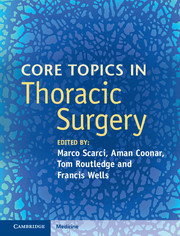Book contents
- Frontmatter
- Contents
- List of contributors
- Section I Diagnostic work-up of the thoracic surgery patient
- Section II Upper airway
- Section III Benign conditions of the lung
- 7 Congenital and developmental lung malformations
- 8 Lung volume reduction surgery for the treatment of advanced emphysema
- 9 Surgical aspects of infectious conditions of the lung
- 10 Treatment of haemoptysis
- Section IV Malignant conditions of the lung
- Section V Diseases of the pleura
- Section VI Diseases of the chest wall and diaphragm
- Section VII Disorders of the esophagus
- Section VIII Other topics
- Index
- References
8 - Lung volume reduction surgery for the treatment of advanced emphysema
from Section III - Benign conditions of the lung
Published online by Cambridge University Press: 05 September 2016
- Frontmatter
- Contents
- List of contributors
- Section I Diagnostic work-up of the thoracic surgery patient
- Section II Upper airway
- Section III Benign conditions of the lung
- 7 Congenital and developmental lung malformations
- 8 Lung volume reduction surgery for the treatment of advanced emphysema
- 9 Surgical aspects of infectious conditions of the lung
- 10 Treatment of haemoptysis
- Section IV Malignant conditions of the lung
- Section V Diseases of the pleura
- Section VI Diseases of the chest wall and diaphragm
- Section VII Disorders of the esophagus
- Section VIII Other topics
- Index
- References
Summary
Introduction
Chronic obstructive pulmonary disease (COPD) is a common worldwide problem associated with morbidity and mortality that, unlike other diseases, is increasing. Recently, COPD has become the third leading cause of death in the United States, an event that was not predicted to occur until the year 2020. Therapy for COPD focuses on smoking cessation, bronchodilators, oxygen therapy, pulmonary rehabilitation, lung volume reduction surgery (LVRS), transplantation and treatment of comorbidities. While many of these interventions may improve dyspnea and quality of life, only oxygen supplementation in those with hypoxemia at rest, smoking cessation and LVRS have been associated with improved mortality in COPD. This chapter will review the role of LVRS in the treatment of patients with advanced COPD, and also examine the current status of minimally invasive bronchoscopic techniques for lung reduction that are approved overseas but are currently under study in the United States.
Rationale for lung reduction in COPD
COPD is an inflammatory disease that leads to airflow obstruction secondary to a combination of airway disease and emphysema, primarily in the distal small airways of the lung. The small airways become narrowed due to airway inflammation, smooth muscle hypertrophy, peribronchial fibrosis and mucus plugging. In emphysema, the destruction of alveolar walls leads to a loss of tethering of distal small airways, predisposing the airway to expiratory collapse. Most individuals with COPD will have a mixture of small airways obstruction and emphysema, but some will have a predominance of one abnormality or the other. Lung emptying is determined by the expiratory time constant, which is the product of airway resistance and lung compliance. Because subjects with emphysema have both increased lung compliance and airways resistance, they have impaired lung emptying and are prone to hyperinflation. As emphysema progresses, total lung capacity (TLC) and residual volume (RV) both increase as a result of decreased lung compliance and unopposed chest wall recoil causing hyperinflation and gas trapping, respectively. During exertion, the respiratory rate increases, reducing the time available for lung emptying, and the end-expiratory lung volume (EELV) rises even further, leading to dynamic hyperinflation. Figure 8.1 demonstrates the rise in lung volumes that occurs during exercise in severe COPD. EELV rises during exercise, thereby limiting the normal increase in tidal volume that occurs during exercise.
- Type
- Chapter
- Information
- Core Topics in Thoracic Surgery , pp. 69 - 85Publisher: Cambridge University PressPrint publication year: 2016



